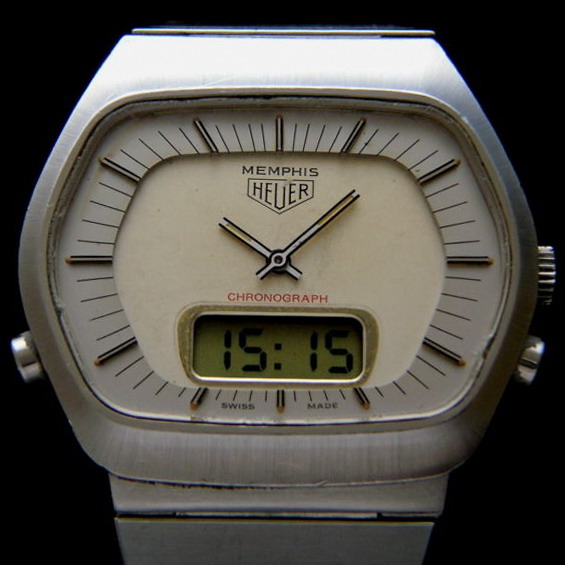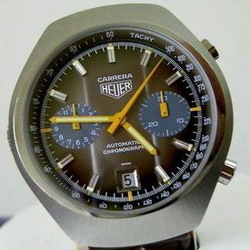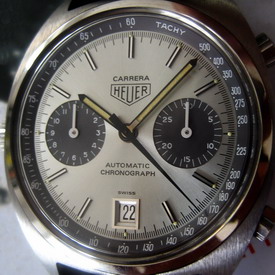| Informational Websites | ChronoMaddox -- the legacy of Chuck Maddox | OnTheDash -- vintage Heuer website | Zowie -- Omega information |
| Discussion Forums | ChronoMaddox Forum | Heuer Forum | Omega Forum |
| Counterfeit Watchers | ChronoTools Forum | ChronoTrader Forum |
|
|
The largest independent, non-commercial, consumer-oriented resource on the Internet for owners, collectors and enthusiasts of fine wristwatches. Online since 1998. | |||||||
|
||||||||
|
||||||||
 |
Vintage Heuer Discussion Forum
The place for discussing 1930-1985 Heuer wristwatches, chronographs and dash-mounted timepieces. Online since May 2003. | ||||||
| |||||||
| |||||||
Fantastic to finally see the connection between the Silverstone (110.313) and the Memphis (371.313)!! I imagine that by the time they were producing the Memphis, they assumed that it was OK to reuse the "313" number (or, more properly, the "31" for this style case)!!
I look forward to studying this fantastic information!!
Jeff
/21SilverstoneRed.jpg)

++++++++++++++++++++++++++++++++++
: The mid-70s continued
: I left off yesterday with the 4- and 5-digit reference numbers
: pretty well understood, but with a lot of questions about how
: the 6-digit references are formed. It suddenly occurred to me
: that one of my assumptions based on the 4 digit schema was
: incorrect for the 6 digit and it was all as clear as day. One of
: those “why didn’t I see it before” moments but hindsight
: is always like that.
: Let’s pick up again with the 5-digit references for the Monacos
: released in 1974 using the Valjoux 7740 movements. These still
: conform to the XXXYZ schema we looked at before for the Vj 773x
: movement family. The first number is removed from the reference
: as unnecessary, as it is always 7 and omitting it doesn’t
: cause any confusion. We can’t say the same for the second 7
: – although always present too, if it was omitted and an XXYZ
: schema as per the automatics was used, you would have some
: references that were quite close to the Autavia and Carrera 45s
: from the 60s.
: So a manual Monaco in steel using the Vj 7740 movement takes a
: reference 74033.
:
: .jpg)
.jpg)
: A 5 digit schema allows for an unambiguous model reference for the
: Carreras and Monacos, but less so for the Autavia as we saw last
: time when the 11630 was introduced. It is this difference in
: case that necessitates the two different references, 1163 and
: 11630 and this provides us with a big clue as to how the 6 digit
: references work.
: I had been assuming that the model line reference (e.g. 3 for
: Monaco, 5 for Carrera etc) would be carried over intact from the
: 4 and 5 digit schemas to the 6 digit. My focus on Carreras
: probably didn’t help here, as the Carrera identifier (5) did
: indeed appear in the reference for the 3rd generation
: “barrel” Carrera e.g. 110.573 F and the late model 2nd
: generation Carrera e.g. 110.253 G. But I had no explanation for
: why the 5 appeared in a different position in each reference.
:
: 

: The amended reference for the Autavia 11630 that didn’t fit into
: the previous schemas was key. It meant for the first time that a
: reference didn’t uniquely resolve to a specific model in a
: specific case. The situation would also shortly be the same for
: Carreras, with barrel cased 3rd generation models being sold
: alongside 2nd generation models. A single model line reference
: wouldn’t cut it and now it becomes clear.
: The six digit schema includes a case reference. Of two digits.
: Sometimes this resolves to a single model line, sometimes model
: lines share a case reference (giving rise to the confusion
: between late Pasadenas and Montreals we saw earlier) and
: sometimes a model line has more than one case type (e.g. barrel
: and 2nd generation Carreras). One place this case reference is
: clear is when comparing late 2nd generation Carreras with the
: 4th generation. They use the same case, as is shown by their
: respective reference numbers – 110.253 and 371.253, the key
: digits being in the 4th and 5th positions.
:
: 
: So the 6 digit references take the format:
: XXX.YYZ
: Where XXX are significant digits from the movement (right packed if
: necessary), YY indicates the case/model and Z again indicates
: the case material.
: Now, this isn’t foolproof. One specific case number appears to be
: used for “miscellaneous” as it crops up on a number of
: otherwise unrelated watches. Also, when the divers come along,
: they use a 6 digit schema all of their own, with the last 3
: digits simply increasing to signify a different model. The late
: PVD and gold-plate Autavias largely conform to this, but the
: right-most digit for the movement is incremented to show
: different case finishes. At this point, Heuer was in different
: ownership, so corporate standards may have changed or not been
: adhered to as closely.
: To add to the confusion, Heuer didn’t adopt this new schema for
: all the existing watches, so we have a number of them in
: operation at once:
: - the 4 digit schema for automatics
: - the 5 digit schema for manuals
: - the 5 digit Autavia schema, amended from the 4 digit
: - the 6 digit schema
: - the 6 digit divers schema
: - and a number of orphan watches with unique numbering, like the
: French-made chronographs.
: So, to break down the reference in more detail:
: XXX.YYZ
: The movement digits XXX can have the following values:
: 102 – Chronosplit LCD/LCD
: 104 – Chronosplit/Manhattan GMT
: 107 – Senator GMT
: 110 – Calibre 11/12
: 150 – Calibre 15
: 279 – ETA 2790
: 361 – ESA quartz
: 365 – ESA quartz/LCD
: 371 – ESA quartz
: 381 - ESA quartz/LCD with alarm
: 423 – Ebauches Bettlach 8420
: 429 – Ebauches Bettlach 8420
: 510 – Lemania 5100/5012
: 733 – Valjoux 7733
: 740 - Valjoux 7740
: 741 – Valjoux 7741
: 750 – Valjoux 7750
: The specific ESA calibres used in the quartz watches tends to
: change with time even where the reference remains the same.
: The Calibre 14 as used in the Autavia GMTs is used on watches with
: the Autavia 5 digit schema, so 140.xxx does not appear.
: The case/model digits YY can have the following values:
: 20 – Daytona
: 21 – Verona
: 22 – Jarama smooth bezel or ridged bezel
: 24 – Jarama ridged bezel
: 25 – Carrera 2nd generation
: 30 – Memphis
: 31 – Silverstone
: 40 – Chronosplit GMT/Manhattan/Senator
: 40 – Silverstone Lemania
: 41 – Senator
: 50 – Montreal
: 50 – Monza
: 50 – Pasadena
: 50 – 1000 Series
: 51 – Carrera 3rd generation “barrel” in gold-plate (wonder if
: this was a typo for 57!)
: 51 – Monza
: 57 – Carrera 3rd generation “barrel”
: 60 – Autavia
: 60 – Regatta
: 63 – Calculator
: 70 – Chronosplit integral case for bracelet
: 70 – Kentucky “horseshoe” case
: 71 – Kentucky twin-LCD case
: 72 – Chronosplit non-integral case for strap
: 80 – Easy Rider
: 80 – Temporada
: You’ll notice that a number of the codes are reused by different,
: later watches with #50 in particular being an issue. I’m not
: really sure what is going on here, whether the numbering schema
: is being amended on the fly or ignored in some instances. The
: format allows them 100 discrete model lines so there is no
: imperative need to reuse numbers. By the 80s, this is getting
: quite common so the list isn’t exhaustive – I believe some
: of the 80s watches are following their own numbering scheme.
: From the stamping of the PVD Monacos (740.303) I believe Heuer were
: considering switching the Monaco to the six digit system but
: then stayed with the 4 and 5 digits schemas. We can derive,
: then, that the Monaco case would have received the code 30. As
: it was unused, this was later “inherited” by the Memphis –
: decide for yourself if it was a worthy successor!
:
: 

: The case material digit Z can have the following values:
: 1 – black PVD or chrome-plate
: 2 – olive PVD
: 3 – steel
: 5 – 16K 20 micron gold-plate
: 6 – gold-plated fibreglass
: 8 – 18K gold
: 9 – fibreglass
: Most of the list is familiar from before, though we have the
: addition of fibreglass materials with the introduction of the
: Temporada and Easy Rider.
: Further research may yet yield more information and patterns to
: consider. The schema as outlined here seems fairly robust from
: 1972 until the late 70s and then becomes more sketchy.
| Chronocentric and zOwie site design and contents (c) Copyright 1998-2005, Derek Ziglar; Copyright 2005-2008, Jeffrey M. Stein. All rights reserved. Use of this web site constitutes acceptance of the terms of use. | CONTACT | TERMS OF USE | TRANSLATE |